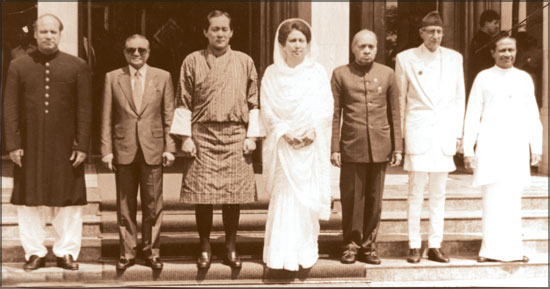SAARC SOCIAL CHARTER SRI LANKA ACTION PLAN 2008-2015
The South Asian Association for Regional Cooperation (SAARC) was
established when its Charter was formally adopted on December 8, 1985 in
Dhaka, Bangladesh, by the leaders of the seven founder member countries
of the SAARC. Afghanistan joined SAARC as the newest member during the
Fourteenth Summit held in New Delhi in the year 2007.
The initial objective of this regional grouping was to improve the
quality of life of the people of South Asia by accelerating the economic
and social development in the region.
The past two decades have witnessed the evolving of SAARC into a
fraternity that promotes joint venture and collaboration. This has
created a favourable environment in the progress of the fulfilment of
the Charter objectives.

At the inception of the Association, the Integrated Programme of
Action (IPA) consisting of a number of Technical Committees (TCs) was
identified as the core areas of cooperation. Over the years, the number
of Technical Committees was changed according to existing requirement.
The current areas of cooperation under the reconstituted Regional
Integrated Programme of Action, pursued through the Technical
Committees, cover Agriculture and Rural Development, Health and
Population Activities, Women, Youth and Children, Environment and
Forestry, Science and Technology and Meteorology, Human Resources
Development and Transport.
In more recent times, high-level Working Groups have also been
established to strengthen cooperation in the areas of Information and
Communications Technology, Biotechnology, Intellectual Property Rights,
Tourism, and Energy.
The Tenth SAARC Summit held in 1998 in Colombo, reviewed the progress
made in the social sector by SAARC and a decision was made to develop a
Social Charter, which would focus on drawing up targets to be achieved
across the region in the areas of poverty alleviation, population
stabilisation, the empowerment of women, youth mobilisation, human
resource development, the promotion of health and nutrition and the
protection of children.
The Twelfth SAARC Summit held in January 2004 in Islamabad Pakistan,
witnessed the signing of the Social Charter. At the Thirteenth SAARC
Summit held in 2005 in Dhaka, Heads of State reiterated their commitment
to take initiatives at national and regional level for achieving the
objectives of the Social Charter.
The SAARC Social Charter, which aims at the promotion of welfare of
the people of South Asia by improving their quality of life, requires
the Member States to formulate a National Plan of Action to
operationalise the provisions of the Charter.
In pursuance of this objective, the Office of the Prime Minister took
the initiative to formulate the National Plan of Action, in consultation
with relevant line Ministries and other governmental and
non-governmental organisations.
This comprehensive document aims at giving effect to the provisions
of the SAARC Social Charter, which are most relevant to Sri Lanka, with
specific goals and targets to be achieved within a specified time frame.
The ‘Empowerment’ of the poor is the main theme of the Sri Lankan
poverty alleviation programs. This includes economic, social,
psychological, cultural and leadership empowerment. The major state
intervention programme for poverty alleviation which is the Samurdhi
program has an island wide coverage including conflict affected areas.
As poverty is considered a composite of many states of deprivation,
the government of Sri Lanka expects to address the following problems as
priorities during the next ten years to reduce poverty and inequality.
The dependency mentality, discrimination against women and children,
top down planning for village development by those who are not sensitive
to village realities, lack of investment within the rural economy from
village savings, and poor social mobilization are among the major
elements causing poverty in Sri Lanka.
It is also needed to divert more resources to economically backward
areas, especially the 119 poorest Divisional Secretaries’ divisions,
through various projects and programs creating conducive environment in
the rural community, and to expand incomes of the poor.
Proper co-ordination of all poverty related projects and programs at
the grass-root level should get the highest priority. Many social
mobilization programs have also been planned to change the attitude and
behaviour of the poor so that they could absorb more resources.
The major components of the Sri Lanka Plan of Action 2008-2015
concentrate especially on children’s health, education, and their
protection as priority areas for investment. |

